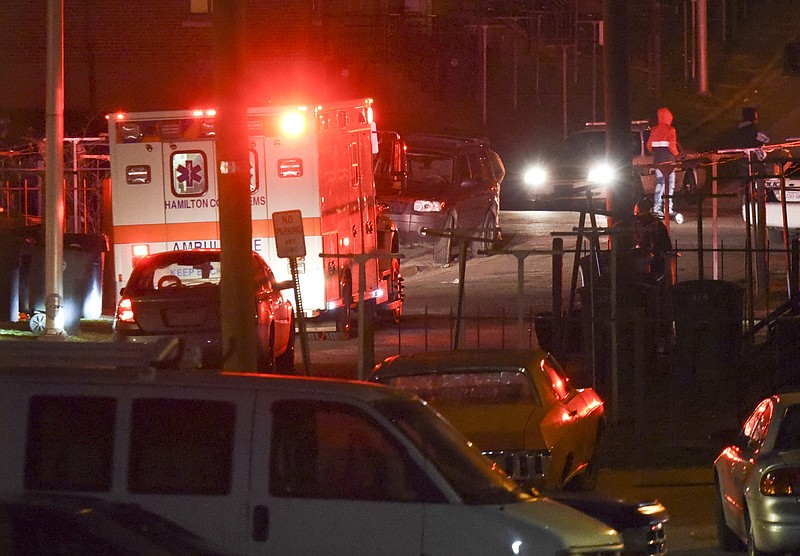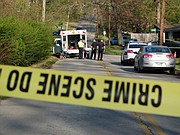Chattanooga saw 34 homicides in 2017, a record number for recent years, but only half of those involved a known gang member - a downturn from 2016, when a bloody gang war erupted into a weeks-long conflict.
Last year's homicides included the deaths of four juveniles and an intellectually disabled man at Orange Grove Center, records show.
The overall number of shootings in the city fell from 158 in 2016 to 147 in 2017, helped along by a nearly 30 percent decline in shootings involving gang members. The portion of both homicides and non-fatal shootings involving gang members also declined by 15 percent and 31 percent, respectively.
"We spent a couple of years really focused on improving the situation when it came to gangs in our community, and the numbers are clear - we've reduced those incidents," Chattanooga Mayor Andy Berke said.
"That was a significant positive development. Not only that, but beyond the numbers, I felt it in the community. People just didn't talk to me about it as much. They didn't seem as concerned about it, and so this fear that is a real thing that affects how people live their lives was down."
The decrease from last year is welcome news, but when placed in a larger context, it represents what is by some metrics a return to normalcy for Chattanooga. The total number of shootings involving gang members in 2017 wound up at 64, just one more than the tally for 2014, a year before the shooting rate jumped by a couple of dozen incidents over 2015 and 2016.
Gang violence has been a focus of the mayor's office and local authorities in recent years, especially since the city launched the Violence Reduction Initiative in March 2014. That effort calls for cooperation by police, prosecutors and social services to crack down on violent offenders while assisting those who want out of that lifestyle through education and job training.
Berke said this year's numbers were a good sign for the city concerning violence involving gang members, but there are a number of separate issues that need to be addressed when trying to drive down violence.
"This year, I think, was positive in our ability to deal with a problem that people have been asking us to work on. We saw those numbers fall," Berke said. "We know that there are a lot of factors that contribute to violence. One is the ready nature of firearms, many of which are illegal in our neighborhoods."
"As I understand it from federal officials, many of the guns in our community have been stolen from people who may have purchased them legally and then distributed to people in Chattanooga who want to use them. We have ramped up the number of guns that we seize in our area, yet we don't hear that anybody is having trouble locating a firearm if they want to," Berke said.
Just as there are many facets to the problem, Berke said there is a wide range of solutions, some of which are already in place and others still being implemented.
"Plans that we've already been making, they tend to hit in stages and waves. We made plans to go up to 500 sworn officers in our city. We did that for a number of reasons, but part of what we wanted to do was make sure there was greater interaction with Chattanoogans. We could get better intelligence. We had more people to respond to all areas of our community," he said.
From 2016 to 2017
Total shooting incidents2016: 1582017: 147Total people shot, excluding justified, accidental, negligent shootings2016: 1602017: 135Total shootings involving gang members2016: 902017: 64
"Even though we made those plans many, many, many months ago, we are just now going to get up to that number."
Leaders at the Chattanooga Police Department have seen firsthand the cumulative effect of investments made over the years as the department has focused on building substantive community relationships in order to cultivate witness cooperation and improve information-gathering efforts.
For example, police say they have received significantly helpful information in nine homicide cases through an anonymous homicide tip line that was put into place in June 2016. The information provided in those phone calls helped boost the department's homicide clearance rate to 70 percent in 2017 - an increase of 30 percent over last year.
Sgt. Josh May, head of the police department's anti-gang violence efforts, said information procured from community members, some of whom are working more closely with law enforcement than they have in years, is an integral part of the department's efforts to put offenders behind bars.
"I think it's just a bunch of things coming together at one time. There's a lot of the social services portion that's coming together. You have quality cases being made by patrol officers as well as our major crimes investigators putting people away [and] our federal partners making good-quality cases," he said.
Information gathered through witness cooperation has also been supplemented by evidence from the department's real-time intelligence center, which was also unveiled last year.
The Chattanooga City Council approved $750,000 at the beginning of 2016 for cameras, software and video networking tools for the center. A portion of that totaling $137,905 was for a contract for 15 pole-mounted cameras and networking software and a $250,000 agreement to install a video monitor wall at the police service center.
May said evidence gathered from the center, paired with information from community members, has been invaluable in solving some homicides, as was the case with the killing of a man set up in an apparent drug deal in November, but each case is different.
"There [was] no shortage of people coming forward with information. You go from having no leads to having a lot of different leads for different reasons. And then on the other end of the spectrum you have people who you say, 'I don't know why this person is dead,' he said. "You have to utilize forensics as well as community input and just good old-fashioned police work."
"You can't have everybody everywhere. We don't have any crystal balls that say this guy is going to kill this person on this night. Financially, we're under a budget as well. Having officers out working overtime is a good thing, but there's no money tree we're getting money off. A lot of it comes down to assistance from the public - having people step up and become violence interrupters."
Looking ahead to 2018, Chattanooga police Chief David Roddy said the department will be doubling down on some of the strategies used to drive down violence involving gang members.
"Using focused deterrence and intelligence-led policing, we've been able to address the numbers that we've been asked as an organization to work on," he said.
Roddy said the department is still expecting to set up a new gun unit in 2018. It will be comprised of a five-person gun team and nine officers organized into rapid response teams tasked with following up on dispatched calls about shots fired throughout the city.
He said the department also will focus on location-based investigations and coordinate with community members to identify solutions to a variety of crimes plaguing particular properties throughout the city. Instructors from the Law Enforcement Innovation Center in Knoxville will be working with Chattanooga police and community members to identify those spots and develop ways to prevent that activity through decisions such as environmental design.
"We're going to bring down some of their instructors two to three times in the next year and provide free training for about 20 to 25 community members including business owners, executives and stakeholders," he said. "We'll provide this type of training specifically to individuals where their location is either where criminal activity is facilitated or is suffering from crime in some way."
"We start to look at this through the crime triangle: victim, suspect and location. If you kick one out, the crime can't occur."
Contact staff writer Emmett Gienapp at egienapp@timesfreepress.com or 423-757-6731. Follow him on Twitter @emmettgienapp.


